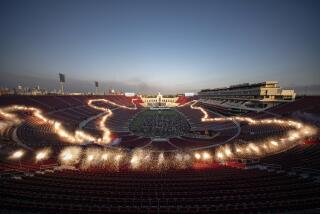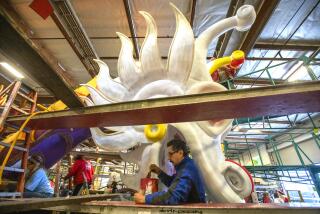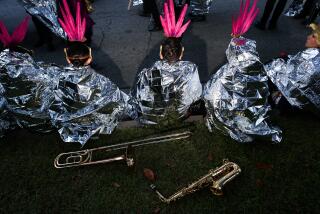From the Archives: Tragedy at the 1926 Rose Parade
The collapse of a grandstand that led to multiple fatalities marred the 1926 Rose Parade. The Jan. 2, 1926, Los Angeles Times reported that about “1,000 men, women and children” were on the grandstand. According to the Times article, about 250 were injured, and “almost twenty in a critical condition.”
Over the next couple months, a total of 11 people died from their injuries.
In a 2003 article headlined ”A Day Filled With Tragedy at Rose Parade,” Los Angeles Times staff writer Cecilia Rasmussen reported:
Consider the 115-year legacy of the Rose Parade: The New Year’s Day spectacle has endured the Depression, wars, detractors, bomb threats, no queen, no theme — even the rise of the parodic Doo-Dah Parade.
But in 1926, the first time the event was broadcast live by radio, tragedy struck. The day remains the deadliest in Rose Parade history. …
The deadly disaster began with a loud crack, like the sound a snapped tree trunk might make. Then a wooden grandstand at the southeast corner of Colorado Boulevard and Madison Avenue crashed to the ground, taking several hundred people with it.
A survivor, William F. Thompson, described the scene to a reporter afterward:
“I was sitting in Row 19, one from the top,” he said. “The parade was passing. Hook and ladder just went by when there was just a slight trembling, and then slowly the whole stand moved forward. I heard boards splintering, women crying and then everything tumbled down.
“Something hit me on the head,” Thompson added. “I was dazed but not clear out. I could see faces of agony all around me. Then I remember someone pulled a board off me, and several men came and dragged me out.
“The last thing I saw as boards and other people fell on me was the arms of a man holding a child over his head,” he said. “This man was partly buried by timbers, but the little girl was safe.”…
Eleven people died of their injuries — some within hours, others within days or months. More than 200 were injured.
Followup investigations determined the grandstand was poorly constructed. Building contractor Paul F. Mahoney was convicted of manslaughter. Mahoney served one year in jail, then was released following successful appeals.
Because of the 1926 collapse, strict construction rules are now enforced at all Tournament of Roses activities.
This restrospective was originally published on Dec. 27, 2011, and updated in 2013.
See more from the Los Angeles Times archives here
More to Read
Sign up for Essential California
The most important California stories and recommendations in your inbox every morning.
You may occasionally receive promotional content from the Los Angeles Times.










